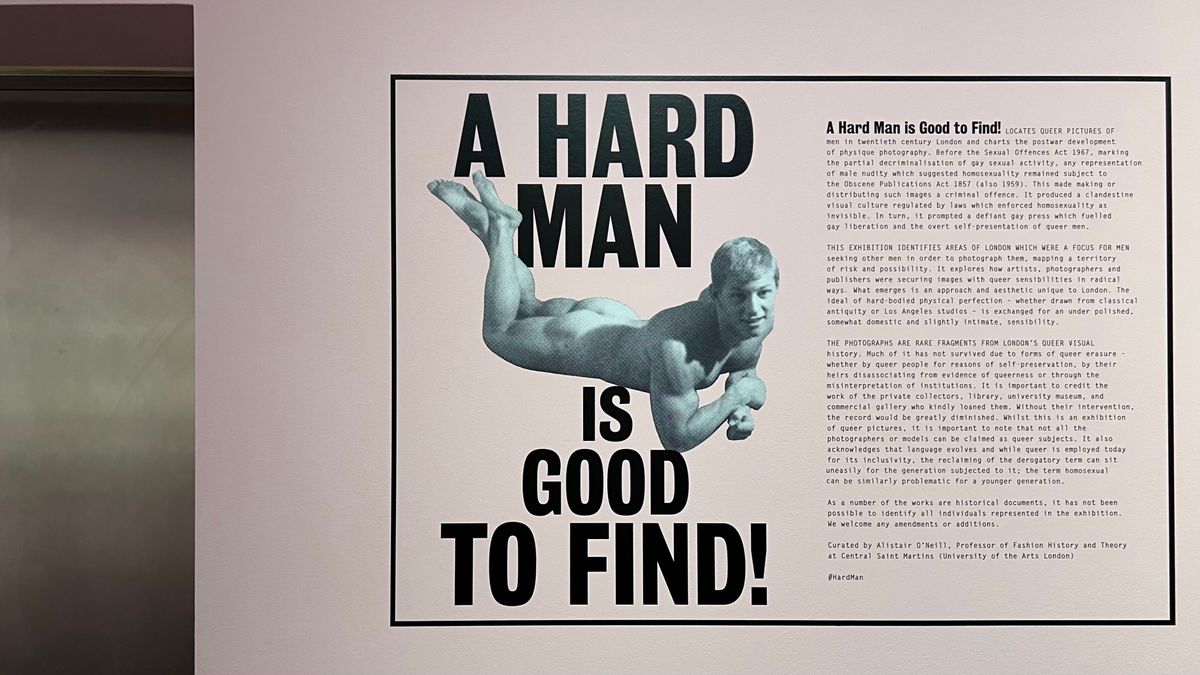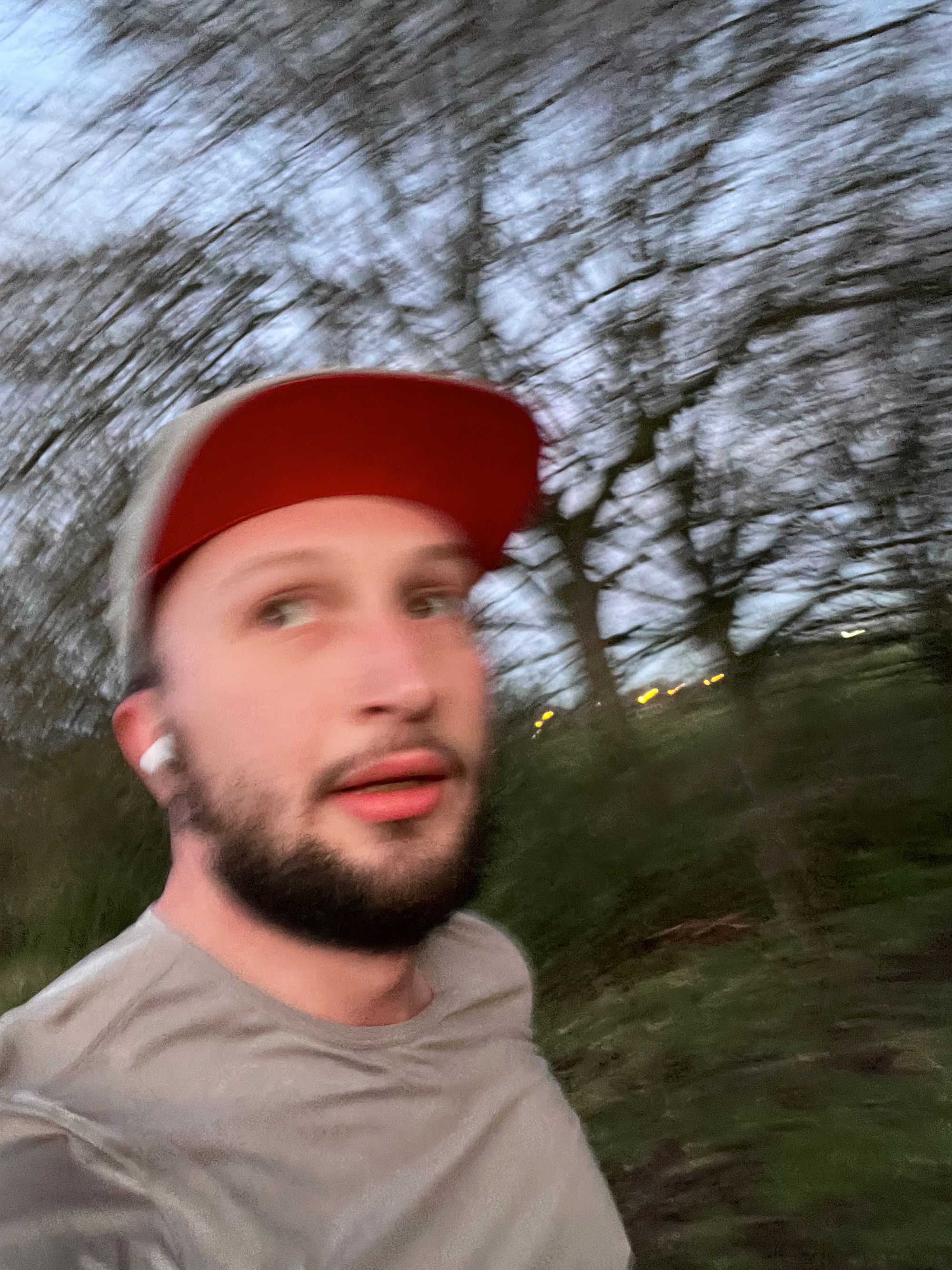Weeknotes 2023.11: feeling like meat on a menu

Every gay couple in London seemed to have the same idea as us on Saturday as we went to see A HARD MAN IS GOOD TO FIND! at the Photographers’ Gallery. This is a bit of a scattergun potpourri of male physique photography over the last century or so, ranging from the inter-war years up until the early 1990s. I say “scattergun” because, although I very much enjoyed the exhibition and would recommend it, I left with rather mixed feelings because of the sheer range of things presented (you can see a limited selection in this Guardian article.)
There is, of course, a clandestine flavour to much of it. Keith Vaughan, for instance, set up his own darkroom at home, and used this to develop photos he’d taken at Highgate men’s pond, resulting in a wonderfully modernist photobook charting the climbing temperatures collaged with glistening physiques roasting as the mercury rose. (Ninety years later, at the Men’s Pond in high summer, not much has changed… save for the posing pouches being replaced by shaped speedos with designs that, while gaudy, are more comfortable. And everyone’s on their phone. And it costs £4.25 to get in now.) But it’s got a timeless appeal to it, as a piece of street photography and skunkworks publication, and it’s easily my favourite part of the exhibition.
There’s a lot here. The ‘catalogues’ with the drawn-on posing pouches (that could be removed by scratching them off.) An example of an actual posing pouch (god, don’t they look uncomfortable and awkward.) And then there’s the set of anonymous negatives bought at Portobello Market, of young men—presumably in the 50s and 60s—in unguarded, casual nude poses in bedrooms and bathrooms and living rooms. The interpretation text explains this, but it does not detail who these people are—it’s hard to see how they could have consented to this. Some of them might well still be alive. As Eddy Frankel’s 3-star review in Time Out says, these men “had no say in their private nude moments being plastered across The Photographers’ Gallery decades after they were taken. This was a time when privacy not only mattered, but had a tangible impact on people’s lives, and this has taken the choice away from them.”
The biggest “yikes” came from John S. Barrington’s œuvre. Some reports claim he used his wife and kids to ‘help his story’ and make it easier to pick up straight-seeming men. The exhibition interpretation text mentions that he claimed to work for Vogue to persuade men to pose for him. To call this questionable is charitable: it’s deception. (He also went on to have sex with some of his models, although he stubbornly considered himself heterosexual.)
The catalogues of models and prints—from Barrington but especially from elsewhere—felt like some analogue Grindr. I wondered how much of these relationships were transactional. There were real men behind each of those tiny photos with numbers, in some cases men who largely didn’t even identify as gay or queer. A typewritten list of models (and sets of prints) had markers: “X” meant circumcised, “C” meant coffee (presumably to indicate they were brown.) This was a spreadsheet, before spreadsheets, and this operation must’ve taken something to run. As a time capsule, it is telling about the dynamics of the gay scene at the time. (Most of these men are probably still around today.)
Although the exhibition didn’t really interrogate these details, it did, at least, acknowledge them. And I guess it’s better for these photos to be on display in a gallery, with context and interpretation, rather than cut out and scanned and posted to content aggregators with #LGBTHistory #LoveWins #DamnHesHot tags and no attribution, to be destined for ahem people’s private collections of this stuff. But even contextualised, it is what it is: a grid of men treated as meat on a menu. It definitely gave me something that I kept thinking about as we headed home.
And then I went for a run, and… well, a thing happened.

I am a cisgender man who presents masculine, so I generally have less to worry about when it comes to my personal safety in public than some. Nonetheless, I was wondering as I set out for a run, around ten past six as the sun was going down, if it was a mistake. It’d be nearing twilight when I got back, and Hackney Marshes is unlit, and besides I have my phone and my headphones and people have killed people over less and I have personal experience of being robbed by a group of kids, and it’s not fun—and I thought ‘sod it, let’s go,’ and had a pretty good run anyway.
And then, as I was walking across a zebra crossing on my way back home, a woman in the stopped car called out to me.
“Sexy!” she whooped. “You have very nice butt cheeks.”
Well. Thirty years of my life, and that's the first time I’ve been catcalled.
I was tired, I was sweaty, it was getting a little chilly and I needed to get home and shower. Had I been in a better mood I might’ve come up with a witty retort (‘thanks, my boyfriend loves them,’ ‘dream on,’ ‘darling, I’m gay.’) In the end I just told her to ‘piss off’ and walked off. I presume she drove off and went along with her evening.
Look, I’m not writing about this to say ‘woe is me’ and seek pity from others for an interaction on the street that lasted all of ten seconds. It’s not even the most uncomfortable I’ve been made to feel in a public place. Ultimately I was just… bemused. Weirded out. A bit annoyed. Part of me thinks I should be angrier. At no point was I seriously concerned this woman was going to get out of her car and pursue me. Maybe I should’ve been. That is the calculus that almost all women, non-binary folks, and effeminate men have to do when navigating the world, and of course women (and femme people in general) are significantly more exposed to catcalling and leering than men like myself.
Even remembering that the overwhelming majority of sexual harassment, assault, and violence is carried out by men towards women (and to a lesser extent, other men) we cannot overlook the fact that some gay men are harassed and assaulted by (straight) women who feel entitled to our bodies as tools of entertainment. (This experience from Patrick Strudwick in 2017 comes to mind—CW for discussion of sexual assault on the link.)
Anyway. That’s what happened. It sucked, and it made me feel weird and annoyed, but I’m alright. And, yes, it made me think more about the exhibition I’d just seen, and the mini-industrial complex of perving on people in public, be that the banned creepshots subreddit or TubeCrush or… gah.
Just don’t give people unwanted sexual attention when you go out on the street, folks, no matter how horny you are or how much you think they’re up for it. Don’t leer, don’t stare, don’t touch, don’t be a creep, no matter your gender, or theirs. It’s not part of the social contract. No-one deserves to be treated like meat on a menu.
Things I have enjoyed this week
Aside from A HARD MAN IS GOOD TO FIND! which is showing at the Photographers’ Gallery until 11th June, here’s a list of things I found interesting, enjoyable, or informative this week:
- On a related note, I enjoyed this street photography video from Karin Majoka at Berlin during Pride weekend. It was heartening to see her explaining her reasoning for seeking permission more than she might normally do as a street photographer, to demonstrate she wasn’t here as a voyeur. Pride festivals are so full of life, but many people there may have good reasons not to be photographed and have that plastered over the internet.
- THE DISAPPOINTING DISTRACTION OF “VEHICULAR CYCLING,” on Oh, The Urbanity! is a short and easily digestible dissection of an extremely harmful policy that has, no doubt, killed many people by driving policy away from separated cycleways. In the UK the effects “just make people behave like vehicles” style planning is still felt to this day—and it’s even worse in the US. No wonder our cycling modal share is so dismal and most of those who do cycle are men. I’m sure the late John Forester truly believed in his vehicular cycling policy—his own ability to cycle like a vehicle probably played into that—but highways engineers around the world with a basic understanding of physics and human psychology should have known better. They didn’t. What an unholy mess we have to clear up after this man.
- TOLKIEN F***ED UP FIRST by Verity Ritchie. I actually agree with a lot of their analyses, even though I really enjoyed Lord of the Rings: The Rings of Power season 1 as a whole. The show is a calculated entertainment product with all the trappings we have come to associate with ‘prestige’ TV (obvious fake-outs, colourblind casting that isn’t all that colourblind, Galadriel seeming too young, general problems with scaling.) The ‘who is Sauron?’ mystery, in particular, was a transparent marketing decision rather than anything that genuinely served the plot, the world, or these characters (even if they mostly pulled it off in the end.) Would Tolkien have hated the show? I think he might’ve liked parts of it, but would definitely have hated what it represents as a product of an entertainment factory, the nu-Isengard of our time with Jeff Bezos as our Saruman.
